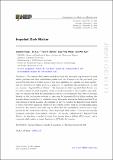| dc.contributor.author | Kopp, Joachim | |
| dc.contributor.author | Liu, Jia | |
| dc.contributor.author | Wang, Xiao-Ping | |
| dc.contributor.author | Slatyer, Tracy Robyn | |
| dc.contributor.author | Xue, Wei | |
| dc.date.accessioned | 2016-12-14T19:45:04Z | |
| dc.date.available | 2016-12-14T19:45:04Z | |
| dc.date.issued | 2016-12 | |
| dc.date.submitted | 2016-11 | |
| dc.identifier.issn | 1029-8479 | |
| dc.identifier.uri | http://hdl.handle.net/1721.1/105818 | |
| dc.description.abstract | We consider dark matter models in which the mass splitting between the dark matter particles and their annihilation products is tiny. Compared to the previously proposed Forbidden Dark Matter scenario, the mass splittings we consider are much smaller, and are allowed to be either positive or negative. To emphasize this modification, we dub our scenario “Impeded Dark Matter”. We demonstrate that Impeded Dark Matter can be easily realized without requiring tuning of model parameters. For negative mass splitting, we demonstrate that the annihilation cross-section for Impeded Dark Matter depends linearly on the dark matter velocity or may even be kinematically forbidden, making this scenario almost insensitive to constraints from the cosmic microwave background and from observations of dwarf galaxies. Accordingly, it may be possible for Impeded Dark Matter to yield observable signals in clusters or the Galactic center, with no corresponding signal in dwarfs. For positive mass splitting, we show that the annihilation cross-section is suppressed by the small mass splitting, which helps light dark matter to survive increasingly stringent constraints from indirect searches. As specific realizations for Impeded Dark Matter, we introduce a model of vector dark matter from a hidden SU(2) sector, and a composite dark matter scenario based on a QCD-like dark sector. | en_US |
| dc.description.sponsorship | United States. Dept. of Energy (Contracts DE−SC00012567 and DE−SC0013999) | en_US |
| dc.publisher | Springer Berlin Heidelberg | en_US |
| dc.relation.isversionof | http://dx.doi.org/10.1007/JHEP12(2016)033 | en_US |
| dc.rights | Creative Commons Attribution | en_US |
| dc.rights.uri | http://creativecommons.org/licenses/by/4.0/ | en_US |
| dc.source | Springer Berlin Heidelberg | en_US |
| dc.title | Impeded Dark Matter | en_US |
| dc.type | Article | en_US |
| dc.identifier.citation | Kopp, Joachim et al. “Impeded Dark Matter.” Journal of High Energy Physics 2016.12 (2016): n. pag. | en_US |
| dc.contributor.department | Massachusetts Institute of Technology. Center for Theoretical Physics | en_US |
| dc.contributor.department | Massachusetts Institute of Technology. Department of Physics | en_US |
| dc.contributor.mitauthor | Slatyer, Tracy Robyn | |
| dc.contributor.mitauthor | Xue, Wei | |
| dc.relation.journal | Journal of High Energy Physics | en_US |
| dc.eprint.version | Final published version | en_US |
| dc.type.uri | http://purl.org/eprint/type/JournalArticle | en_US |
| eprint.status | http://purl.org/eprint/status/PeerReviewed | en_US |
| dc.date.updated | 2016-12-14T05:10:49Z | |
| dc.language.rfc3066 | en | |
| dc.rights.holder | The Author(s) | |
| dspace.orderedauthors | Kopp, Joachim; Liu, Jia; Slatyer, Tracy R.; Wang, Xiao-Ping; Xue, Wei | en_US |
| dspace.embargo.terms | N | en_US |
| dc.identifier.orcid | https://orcid.org/0000-0001-9699-9047 | |
| dc.identifier.orcid | https://orcid.org/0000-0002-6809-7545 | |
| mit.license | PUBLISHER_CC | en_US |
